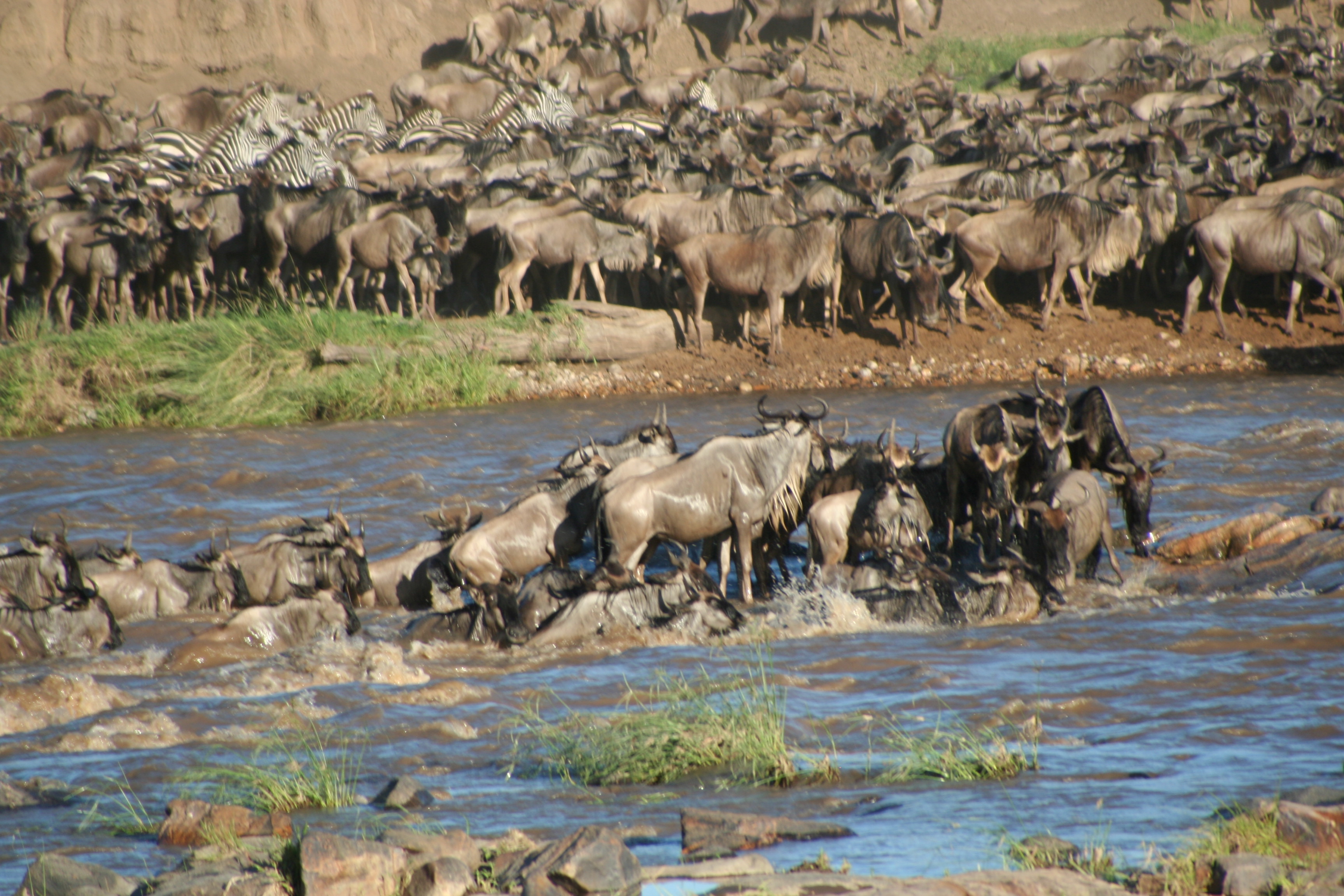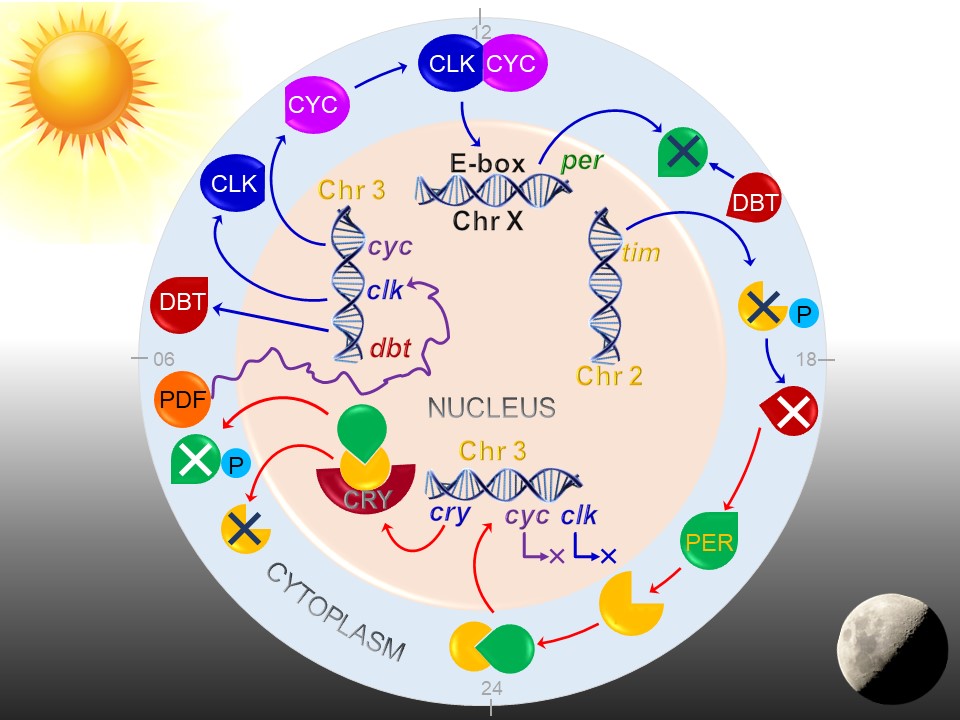|
Infradian
In chronobiology, an infradian rhythm is a rhythm with a period longer than the period of a circadian rhythm, i.e., with a frequency of less than one cycle in 24 hours. Some examples of infradian rhythms in mammals include menstruation, breeding, migration, hibernation, molting and fur or hair growth, and tidal or seasonal rhythms. In contrast, ultradian rhythms have periods shorter than the period of a circadian rhythm. Several infradian rhythms are known to be caused by hormone stimulation or exogenous factors. For example, seasonal depression, an example of an infradian rhythm occurring once a year, can be caused by the systematic lowering of light levels during the winter. See also * Photoperiodicity A circadian rhythm (), or circadian cycle, is a natural, internal process that regulates the sleep–wake cycle and repeats roughly every 24 hours. It can refer to any process that originates within an organism (i.e., Endogeny (biology), endogeno ... References Chronobio ... [...More Info...] [...Related Items...] OR: [Wikipedia] [Google] [Baidu] |
Ultradian Rhythm
In chronobiology, an ultradian rhythm is a recurrent period or cycle repeated throughout a 24-hour day. In contrast, circadian rhythms complete one cycle daily, while infradian rhythms such as the human menstrual cycle have periods longer than a day. The ''Oxford English Dictionary's'' definition of ''Ultradian'' specifies that it refers to cycles with a period shorter than a day but longer than an hour. The descriptive term ultradian is used in sleep research in reference to the 90–120 minute cycling of the sleep stages during human sleep. There is a circasemidian rhythm in body temperature and cognitive function which is technically ultradian. However, this appears to be the first harmonic of the circadian rhythm of each and not an endogenous rhythm with its own rhythm generator. Other ultradian rhythms include blood circulation, blinking, pulse, hormonal secretions such as growth hormone, heart rate, thermoregulation, micturition, bowel activity, nostril dilation, ap ... [...More Info...] [...Related Items...] OR: [Wikipedia] [Google] [Baidu] |
Chronobiology
Chronobiology is a field of biology that examines timing processes, including periodic (cyclic) phenomena in living organisms, such as their adaptation to solar- and lunar-related rhythms. These cycles are known as biological rhythms. Chronobiology comes from the ancient Greek χρόνος (''chrónos'', meaning "time"), and biology, which pertains to the study, or science, of life. The related terms ''chronomics'' and ''chronome'' have been used in some cases to describe either the molecular mechanisms involved in chronobiological phenomena or the more quantitative aspects of chronobiology, particularly where comparison of cycles between organisms is required. Chronobiological studies include but are not limited to comparative anatomy, physiology, genetics, molecular biology and behavior of organisms related to their biological rhythms. Other aspects include epigenetics, development, reproduction, ecology and evolution. The subject Chronobiology studies variations of the ... [...More Info...] [...Related Items...] OR: [Wikipedia] [Google] [Baidu] |
Circadian Rhythm
A circadian rhythm (), or circadian cycle, is a natural, internal process that regulates the sleep–wake cycle and repeats roughly every 24 hours. It can refer to any process that originates within an organism (i.e., endogenous) and responds to the environment ( entrained by the environment). These 24-hour rhythms are driven by a circadian clock, and they have been widely observed in animals, plants, fungi and cyanobacteria. The term ''circadian'' comes from the Latin ''circa'', meaning "approximately", and ''dies'', meaning "day". Processes with 24-hour cycles are more generally called diurnal rhythms; diurnal rhythms should not be called circadian rhythms unless they can be confirmed as endogenous, and not environmental. Although circadian rhythms are endogenous, they are adjusted to the local environment by external cues called zeitgebers (German for "time givers"), which include light, temperature and redox cycles. In clinical settings, an abnormal circadian rhythm in h ... [...More Info...] [...Related Items...] OR: [Wikipedia] [Google] [Baidu] |
Menstrual Cycle
The menstrual cycle is a series of natural changes in hormone production and the structures of the uterus and ovaries of the female reproductive system that make pregnancy possible. The ovarian cycle controls the production and release of eggs and the cyclic release of estrogen and progesterone. The uterine cycle governs the preparation and maintenance of the lining of the uterus (womb) to receive an embryo. These cycles are concurrent and coordinated, normally last between 21 and 35 days, with a median length of 28 days, and continue for about 30–45 years. Naturally occurring hormones drive the cycles; the cyclical rise and fall of the follicle stimulating hormone prompts the production and growth of oocytes (immature egg cells). The hormone estrogen stimulates the uterus lining ( endometrium) to thicken to accommodate an embryo should fertilization occur. The blood supply of the thickened lining provides nutrients to a successfully implanted embryo. If implantation does n ... [...More Info...] [...Related Items...] OR: [Wikipedia] [Google] [Baidu] |
Sexual Reproduction
Sexual reproduction is a type of reproduction that involves a complex life cycle in which a gamete ( haploid reproductive cells, such as a sperm or egg cell) with a single set of chromosomes combines with another gamete to produce a zygote that develops into an organism composed of cells with two sets of chromosomes ( diploid). This is typical in animals, though the number of chromosome sets and how that number changes in sexual reproduction varies, especially among plants, fungi, and other eukaryotes. Sexual reproduction is the most common life cycle in multicellular eukaryotes, such as animals, fungi and plants. Sexual reproduction also occurs in some unicellular eukaryotes. Sexual reproduction does not occur in prokaryotes, unicellular organisms without cell nuclei, such bacteria and archaea. However, some process in bacteria may be considered analogous to sexual reproduction in that they incorporate new genetic information, including bacterial conjugation, transform ... [...More Info...] [...Related Items...] OR: [Wikipedia] [Google] [Baidu] |
Migration (ecology)
Migration, in ecology, is the large-scale movement of members of a species to a different environment. Migration is a natural behavior and component of the life cycle of many species of mobile organisms, not limited to animals, though animal migration is the best known type. Migration is often cyclical, frequently occurring on a seasonal basis, and in some cases on a daily basis. Species migrate to take advantage of more favorable conditions with respect to food availability, safety from predation, mating opportunity, or other environmental factors. While members of some species learn a migratory route on their first journey with older members of their group, other species genetically pass on information regarding their migratory paths. Despite many differences in organisms’ migratory cues and behaviors, “considerable similarities appear to exist in the cues involved in the different phases of migration.” Migratory organisms use environmental cues like photoperiod and we ... [...More Info...] [...Related Items...] OR: [Wikipedia] [Google] [Baidu] |
Hibernation
Hibernation is a state of minimal activity and metabolic depression undergone by some animal species. Hibernation is a seasonal heterothermy characterized by low body-temperature, slow breathing and heart-rate, and low metabolic rate. It most commonly occurs during winter months. Although traditionally reserved for "deep" hibernators such as rodents, the term has been redefined to include animals such as bears and is now applied based on active metabolic suppression rather than any absolute decline in body temperature. Many experts believe that the processes of daily torpor and hibernation form a continuum and utilise similar mechanisms. The equivalent during the summer months is aestivation. Hibernation functions to conserve energy when sufficient food is not available. To achieve this energy saving, an endothermic animal decreases its metabolic rate and thereby its body temperature. Hibernation may last days, weeks, or months—depending on the species, ambient temperatu ... [...More Info...] [...Related Items...] OR: [Wikipedia] [Google] [Baidu] |
Molting
In biology, moulting (British English), or molting (American English), also known as sloughing, shedding, or in many invertebrates, ecdysis, is the manner in which an animal routinely casts off a part of its body (often, but not always, an outer layer or covering), either at specific times of the year, or at specific points in its life cycle. In medieval times it was also known as "mewing" (from the French verb "muer", to moult), a term that lives on in the name of Britain's Royal Mews where the King's hawks used to be kept during moulting time before becoming horse stables after Tudor times. Moulting can involve shedding the epidermis (skin), pelage ( hair, feathers, fur, wool), or other external layer. In some groups, other body parts may be shed, for example, the entire exoskeleton in arthropods, including the wings in some insects. Examples In birds In birds, moulting is the periodic replacement of feathers by shedding old feathers while producing new ones. Feathers ... [...More Info...] [...Related Items...] OR: [Wikipedia] [Google] [Baidu] |
Human Hair Growth
The growth of human hair occurs everywhere on the body except for the soles of the feet, the inside of the mouth, the lips, the backs of the ears, the palms of the hands, some external genital areas, the navel, scar tissue, and, apart from eyelashes, the eyelids. Hair is a stratified squamous keratinized epithelium made of multi-layered flat cells whose rope-like filaments provide structure and strength to the hair shaft. The protein called keratin makes up hair and stimulates hair growth. Hair follows a specific growth cycle with three distinct and concurrent phases: anagen, catagen, and telogen. Each phase has specific characteristics that determine the length of the hair. The body has different types of hair, including vellus hair and androgenic hair, each with its own type of cellular construction. This varied construction gives the hair unique characteristics, serving specific purposes, mainly warmth (redundant in modern humans) and physical protection. Most humans devel ... [...More Info...] [...Related Items...] OR: [Wikipedia] [Google] [Baidu] |
Photoperiodicity
A circadian rhythm (), or circadian cycle, is a natural, internal process that regulates the sleep–wake cycle and repeats roughly every 24 hours. It can refer to any process that originates within an organism (i.e., Endogeny (biology), endogenous) and responds to the environment (Entrainment (chronobiology), entrained by the environment). These 24-hour rhythms are driven by a circadian clock, and they have been widely observed in animals, plants, fungi and cyanobacteria. The term ''circadian'' comes from the Latin ''wikt:circa#Latin, circa'', meaning "approximately", and ''dies'', meaning "day". Processes with 24-hour cycles are more generally called diurnal rhythms; diurnal rhythms should not be called circadian rhythms unless they can be confirmed as endogenous, and not environmental. Although circadian rhythms are endogenous, they are adjusted to the local environment by external cues called zeitgebers (German for "time givers"), which include light, temperature and redox cy ... [...More Info...] [...Related Items...] OR: [Wikipedia] [Google] [Baidu] |
.png)




